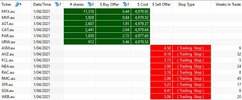MovingAverage
Just a retail hack
- Joined
- 23 January 2010
- Posts
- 1,315
- Reactions
- 2,565
A better description
Trading a range of “strategies” smooths the consistency of returns.
Skate,

if this can help you, you are not the only one to have suffered during that periodHere's how mine tracked. Started with Zebra and added a few more strategies at the start of the year which have been swung around hard in Feb/March.
View attachment 122316
True happiness (IMHO)
My definition of true happiness is ‘desiring’ what you have!! --- not appreciating what you have.
Well what's the difference ?
1. "Desire" is a deep feeling
2. "Appreciating" is acknowledging the worth of someone or something.



I have a lot of similar tickers in my buys...View attachment 122359
View attachment 122360
View attachment 122361
A good strategy takes time to develop
Those new to trading are very concerned about finding a strategy that works quickly while at the same time quickly dismiss a good strategy that refuses to display early gains. At times, simple trading rules have often become the foundation of a good strategy.
The Sphere Strategy
This "Sphere Strategy" came from a post about back in 2016. With a small twist, I approached the idea from a different angle. Paper trading this (crazy) idea is important to determine if the idea will have an edge (over time).
Skate
Hello all
I am reaching out to the pros here. how would one code the following:
if the price is = to or > than the buy price by 100 percent. i.e 100 percent profit. close the trade at next candle.
This is exactly the same as the applystop function:
amount = 100; // 100% profit
ApplyStop( stopTypeProfit, stopModePercent, amount, True );
I would like to do it without the applystop function; as the applystop doesnt spit out trades in explorer.
The reason i ask. i was in an open position and at the end of the week was %140 percent profit. Really nice. my system didn't trigger a sell for any reason, which is fine. However, come into this week, the prick came back to about 40 percent profit only. Triggered a sell this week, but i almost feel like it should of closed last week. "dont be greedy" type mentality. It could be a better system i think.
Using the apply stop function to test the methodology my CAR increased by 10%, so the idea is worth exploring.
any help is appreciated
 www.aussiestockforums.com
www.aussiestockforums.com
if you have a weekly system and want to exit within the week, a bit complicatedHello all
I am reaching out to the pros here. how would one code the following:
if the price is = to or > than the buy price by 100 percent. i.e 100 percent profit. close the trade at next candle.
This is exactly the same as the applystop function:
amount = 100; // 100% profit
ApplyStop( stopTypeProfit, stopModePercent, amount, True );
I would like to do it without the applystop function; as the applystop doesnt spit out trades in explorer.
The reason i ask. i was in an open position and at the end of the week was %140 percent profit. Really nice. my system didn't trigger a sell for any reason, which is fine. However, come into this week, the prick came back to about 40 percent profit only. Triggered a sell this week, but i almost feel like it should of closed last week. "dont be greedy" type mentality. It could be a better system i think.
Using the apply stop function to test the methodology my CAR increased by 10%, so the idea is worth exploring.
any help is appreciated
not tested..if you have a weekly system and want to exit within the week, a bit complicated
But otherwise just add an EXIT:
Sell=Sell OR C>=BuyPrice*2;
Hello and welcome to Aussie Stock Forums!
To gain full access you must register. Registration is free and takes only a few seconds to complete.
Already a member? Log in here.